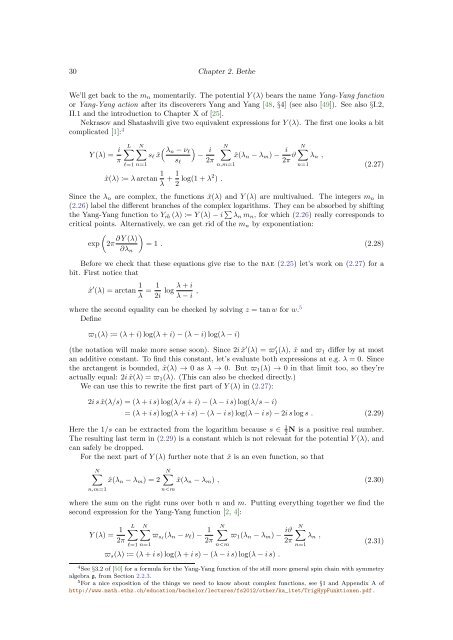The Bethe/Gauge Correspondence
The Bethe/Gauge Correspondence
The Bethe/Gauge Correspondence
You also want an ePaper? Increase the reach of your titles
YUMPU automatically turns print PDFs into web optimized ePapers that Google loves.
30 Chapter 2. <strong>Bethe</strong>We’ll get back to the m n momentarily. <strong>The</strong> potential Y (λ) bears the name Yang-Yang functionor Yang-Yang action after its discoverers Yang and Yang [48, §4] (see also [49]). See also §I.2,II.1 and the introduction to Chapter X of [25].Nekrasov and Shatashvili give two equivalent expressions for Y (λ). <strong>The</strong> first one looks a bitcomplicated [1]: 4Y (λ) = i πL∑N∑l=1 n=1( λn − ν)ls l ˆx − is l 2πˆx(λ) := λ arctan 1 λ + 1 2 log(1 + λ2 ) .N∑ˆx(λ n − λ m ) − iN 2π ϑ ∑λ n ,n,m=1n=1(2.27)Since the λ n are complex, the functions ˆx(λ) and Y (λ) are multivalued. <strong>The</strong> integers m n in(2.26) label the different branches of the complex logarithms. <strong>The</strong>y can be absorbed by shiftingthe Yang-Yang function to Y ⃗m (λ) := Y (λ) − i ∑ λ n m n , for which (2.26) really corresponds tocritical points. Alternatively, we can get rid of the m n by exponentiation:(exp 2π ∂ Y (λ) )= 1 . (2.28)∂λ nBefore we check that these equations give rise to the bae (2.25) let’s work on (2.27) for abit. First notice thatˆx ′ (λ) = arctan 1 λ = 1 2i log λ + iλ − i ,where the second equality can be checked by solving z = tan w for w. 5Defineϖ 1 (λ) := (λ + i) log(λ + i) − (λ − i) log(λ − i)(the notation will make more sense soon). Since 2i ˆx ′ (λ) = ϖ ′ 1(λ), ˆx and ϖ 1 differ by at mostan additive constant. To find this constant, let’s evaluate both expressions at e.g. λ = 0. Sincethe arctangent is bounded, ˆx(λ) → 0 as λ → 0. But ϖ 1 (λ) → 0 in that limit too, so they’reactually equal: 2i ˆx(λ) = ϖ 1 (λ). (This can also be checked directly.)We can use this to rewrite the first part of Y (λ) in (2.27):2i s ˆx(λ/s) = (λ + i s) log(λ/s + i) − (λ − i s) log(λ/s − i)= (λ + i s) log(λ + i s) − (λ − i s) log(λ − i s) − 2i s log s . (2.29)Here the 1/s can be extracted from the logarithm because s ∈ 1 2N is a positive real number.<strong>The</strong> resulting last term in (2.29) is a constant which is not relevant for the potential Y (λ), andcan safely be dropped.For the next part of Y (λ) further note that ˆx is an even function, so thatN∑n,m=1ˆx(λ n − λ m ) = 2N∑ˆx(λ n − λ m ) , (2.30)n
















